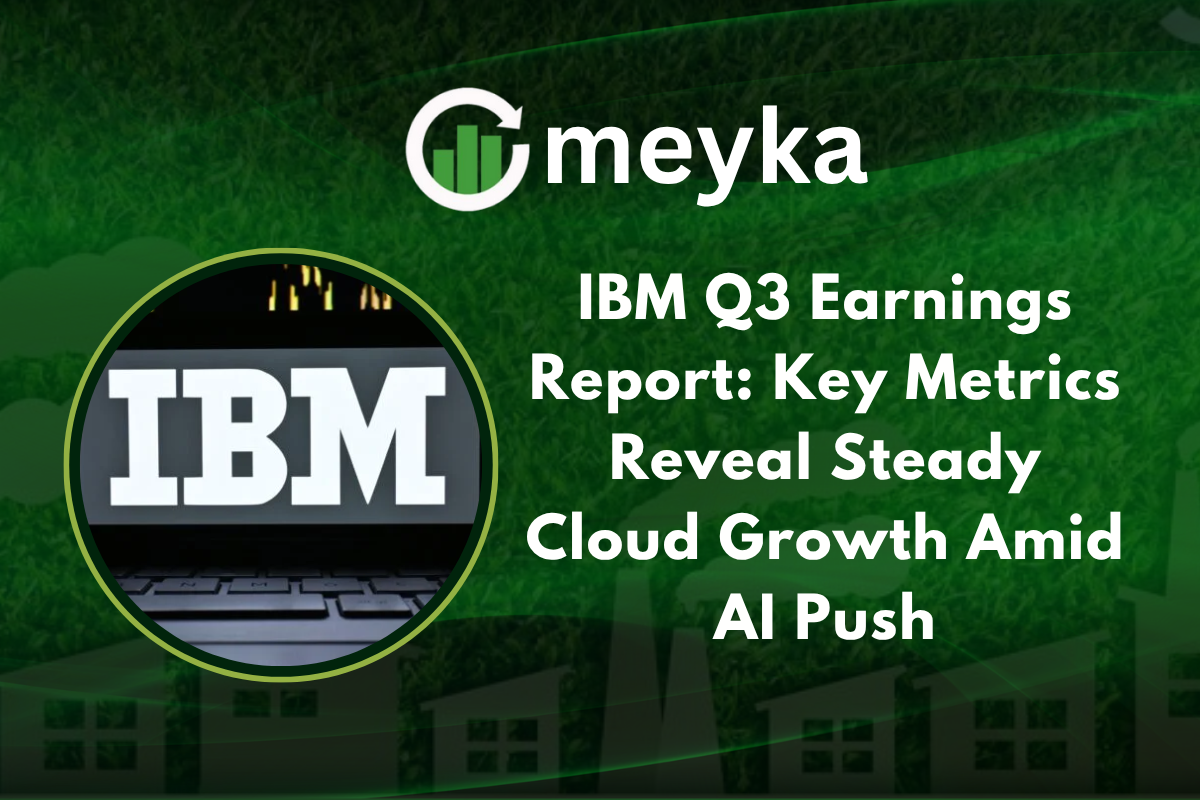IBM Q3 Earnings Report: Key Metrics Reveal Steady Cloud Growth Amid AI Push
IBM Q3 results show a clear message: steady growth, stronger profits, and a rising AI story. The company reported $16.3 billion in revenue, a 9 percent year-over-year increase, and raised full-year outlooks.
IBM’s (IBM) software, infrastructure, and AI businesses powered the quarter, led by a growing Watsonx book of business and demand for AI-ready mainframes. Investors and analysts gave mixed immediate reactions, but the report reinforced IBM’s AI and hybrid cloud strategy.
IBM Q3 Shows Consistent Growth Across Cloud and AI Segments
IBM’s quarter combined recurring software strength with a surprising infrastructure jump. The company posted revenue of $16.3 billion, up 9 percent, with software revenue up 10 percent and infrastructure revenue up 17 percent. Management called out AI as a core growth engine; IBM’s AI book of business expanded to more than $9.5 billion.
That helped lift margins and free cash flow, prompting IBM to raise its full-year revenue and free cash flow outlooks.
Why did IBM perform well this quarter? Enterprise clients are adopting IBM’s Watsonx AI stack and moving workloads to a hybrid cloud. Software subscriptions and mainframe sales drove steady, higher-margin revenue.
Software and Cloud Drive IBM’s Strong Q3 Performance
IBM’s software portfolio led with $7.2 billion in software revenue, showing broad strength across automation, data, and hybrid cloud. Red Hat-related hybrid cloud grew, though Reuters notes growth in that unit slowed to 14 percent from 16 percent in the prior quarter.
Still, automation climbed 24 percent, and hybrid infrastructure rose sharply, helping offset slower accelerations elsewhere.
Analysts highlighted that software sales, including recurring and SaaS metrics, are the clearest path to lasting margin gains.
AI and Watsonx Take Center Stage in IBM’s Strategy
Watsonx was central to IBM’s narrative. CEO Arvind Krishna said clients are using Watsonx to automate workflows and build industry models, contributing to the AI book of business growth. IBM described how AI monetization spans software, consulting services, and new SaaS annual contract value. That makes AI less of an experiment and more of an embedded revenue stream.
How is AI shaping IBM’s business transformation? AI is woven into software, consulting, and infrastructure, improving productivity for clients and creating high-margin recurring revenue for IBM.
Mainframe and Infrastructure Remain Key Support Pillars
Infrastructure surprised to the upside. IBM’s (IBM) infrastructure revenue rose 17 percent to $3.6 billion, driven by AI-ready mainframes. Reuters noted that AI-focused mainframe demand, especially in financial services, helped lift.
The z-systems business showed strong growth, with IBM Z up 61 percent, underscoring how regulated industries seek on-prem AI platforms for data residency and encryption. This hardware strength balanced software growth and supported margins.
IBM’s Profit Margins and Stock Performance Post-Q3 Results
Profitability improved, with GAAP gross profit margin at 57.3 percent and operating (non-GAAP) margin at 58.7 percent, both rising year over year. IBM (IBM) generated strong cash flows: third-quarter free cash flow was $2.4 billion, and net cash from operations was $3.1 billion.
The firm returned $1.6 billion to shareholders in dividends during the quarter. Despite these metrics, Reuters reported a sell-off in after-hours trading as some investors fretted over a slowdown in Red Hat growth.
How did investors react to IBM Q3 results? Shares ticked lower in extended trading on concerns that cloud growth decelerated, even though core metrics beat estimates and margins improved.
AI Stock Research Highlights IBM’s Market Strength
Quant and data teams increasingly tag IBM as a play in enterprise AI. AI Stock Research tools show rising investor interest as IBM (IBM) converts AI projects into contractual revenue. These models flag IBM’s combination of software subscriptions, consulting signings, and AI mainframes as a differentiated earnings mix among legacy tech firms.
Analysts say that the ramp in AI offerings could support valuation if growth stays durable.
Analyst Reactions and Forward Outlook for IBM Q4
Analysts praised IBM’s ability to grow revenue and cash flow, but they also urged caution on the pace of cloud acceleration. Reuters quotes management forecasting hybrid cloud will return to mid-teen growth, while IBM raised full-year revenue growth guidance to more than 5 percent at constant currency.
GuruFocus and others noted IBM’s strategic positioning in AI and its consistent cash generation as positives for long-term investors.
What’s next for IBM in the AI race? Expect deeper Watsonx partnerships, expanded AI consulting programs, and continued investment in AI hardware and quantum research to differentiate offerings.
AI Stock Analysis Predicts Positive Long-Term Trajectory
Market-facing models that combine fundamentals and alternative data often label IBM a late-cycle tech beneficiary. AI Stock Analysis models used by some firms project steady margins as the software mix and mainframe sales sustain gross margins while consulting scales.
The key watch items are Red Hat growth pacing, new SaaS ACV signings, and whether the AI pipeline converts to predictable, recurring revenue.
IBM’s AI Ecosystem and Partnerships Strengthen Global Reach
IBM highlighted expansions across banking, telecom, manufacturing, and public sector clients. The company is packaging AI with compliance controls, hybrid deployment options, and industry models.
These partnerships help IBM sell larger consulting engagements that include software, cloud migration, and AI model implementation, creating sticky customer relationships and long revenue tails.
Conclusion: IBM Q3 Marks a Confident Step into the AI Future
IBM (IBM) Q3 delivered a strong set of metrics: revenue of $16.3 billion, rising margins, robust free cash flow, and a $9.5 billion AI book of business. The quarter showed IBM can grow at the intersection of AI and hybrid cloud while monetizing infrastructure gains. Short-term investor reaction reflected concern about cloud growth pacing.
Over the medium term, IBM’s focus on Watsonx, mainframe AI, and recurring software positions it well to capture enterprise AI spending. For investors watching IBM’s AI journey, Q3 was a measured, credible step forward.
FAQ’S
IBM reported stronger-than-expected Q3 results, with revenue and earnings growth driven by its AI and hybrid cloud businesses.
Analysts expect steady growth in IBM’s software and consulting divisions, fueled by enterprise demand for AI and cloud transformation.
Yes, IBM is considered a solid AI stock due to its investments in Watsonx and enterprise AI solutions that boost long-term growth potential.
IBM stock fell recently due to profit-taking, macroeconomic uncertainty, and cautious guidance despite strong AI-related performance.
Disclaimer
The content shared by Meyka AI PTY LTD is solely for research and informational purposes. Meyka is not a financial advisory service, and the information provided should not be considered investment or trading advice.”






